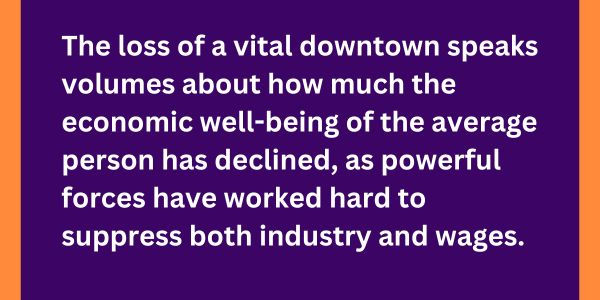From Blue Sky Ranch to Big Ag: A Family Farmer's Perspective
- Doug White
- Sep 10
- 3 min read
My grandfather was a second generation American farmer. He and my grandmother started Blue Sky Ranch on Yakima’s Scenic Drive in the 1930s. With about twenty acres of usable land he raised a family of five children. They were poor at the beginning, but over time fruit prices grew and in the 1970s they were finally able to build their forever home and enjoy a good income. Downtown Yakima thrived then with both a Bon Marché and a Nordstrom store. That was a real Nordstrom, not just a Nordstrom Rack. But things began to change. Downward pressure on small farms and the livelihoods they supported came under attack. Shockingly, at this same time, many farmers began to align with the very forces working against them, voting against their own best interests. With the beginning of the Reagan Administration and its radical change to economic policy, compounded by the wider 1980s farm crisis, the negative impact on small farms was second only to that of the Great Depression. While this did trigger some reforms to assist farmers, the policies were most likely to benefit large farms, much as they still do today. |
 It is easy to oversimplify the reasons the consolidation of small farms accelerated, but the 1980s marked a time of transformational corporate greed that brought a far more aggressive focus on profit at any cost. This was the moment when the devil convinced farmers that he didn’t exist and shifted the blame for the world’s problems onto “other people.” Republicans somehow convinced rural America that they were fiscally responsible and had farmers’ best interests at heart, despite all evidence to the contrary. From here it began to snowball as policies continued to support large farms while small farms were continuously marginalized and expected to assume greater risk without receiving the benefits. This was reinforced as policies led to industry shifts in how farming was done. For example, price supports were largely limited to a few crops, mainly dairy and grains. The impact was most apparent in the H-2A visa process. In the 1980s, as borders began to close to migrant farmworkers, the H-2A visa program was created in 1986. In my view, this did great and lasting harm to small farmers. Unable to secure local labor, they were forced to use the H-2A program, which required time, money, and expertise that corporate farms had and small farmers did not. Since then the H-2A program has become a massive industry for lawyers, recruiters, logistics companies, financial institutions, and other players, making it nearly impossible for small farms to participate. How can a small farmer who needs only a few pickers for a few weeks during the year compete with corporate farms that have full time staff dedicated to managing the thousands of H-2A workers they employ? |
 |
Today, the challenges for small farmers remain immense. According to the USDA’s 2022 Census of Agriculture, the average age of a farmer is close to 60 and the average age of a new farmer is nearly 50. The average size of a farm is now about 500 acres, a significant increase from my grandparents’ twenty. What does this say about farm startups when new farmers are nearly fifty years old before they begin? In my circle of small farmers I see a clear trend toward niche farming. Competing in mainstream agriculture with large corporate farms is nearly impossible. But with niche farming comes greater risks and slimmer chances of success. I raise premium poultry, and I must price it about 250 percent higher than store-bought chicken. That means relying on a small and often unstable market of customers who both have the means and the willingness to see the added cost as worthwhile. The financial risks are high, and the rewards are mostly intangible. Still, to me, it feels worth more than money in the bank. |
Newhouse's Red Herring: China's Real Threat While Congressional District 4's Representative, Dan "Do Nothing" Newhouse is shouting that the sky is falling because China-based companies own a few thousand acres of American land, the real threat is much closer to home: our food supply. Two companies, wholly owned by Chinese interests, control the majority of the United States' seed and pork production. |
Will 47 get Bolasarioed? Read this article from Reuters on the rise and fall, fall, fall of Brazil's ex-president Bolasario and find hope. https://www.reuters.com/world/americas/bolsonaro-trial-brazils-supreme-court-nears-verdicts-2025-09-01/ |





Comments